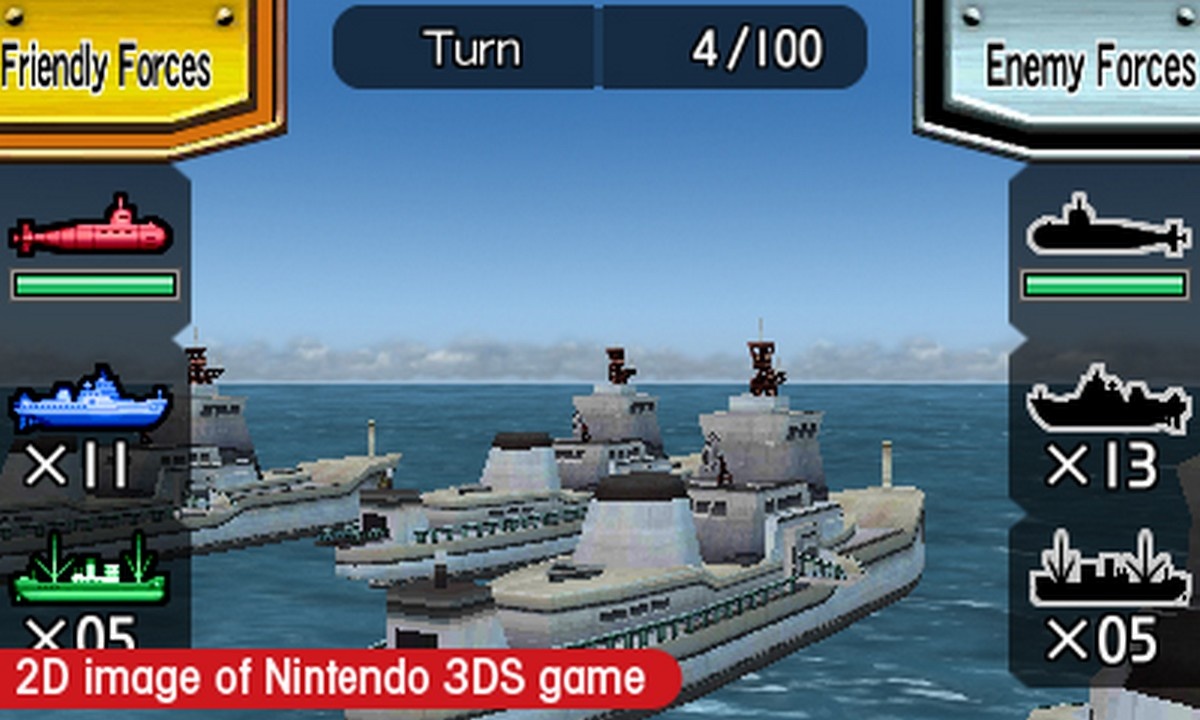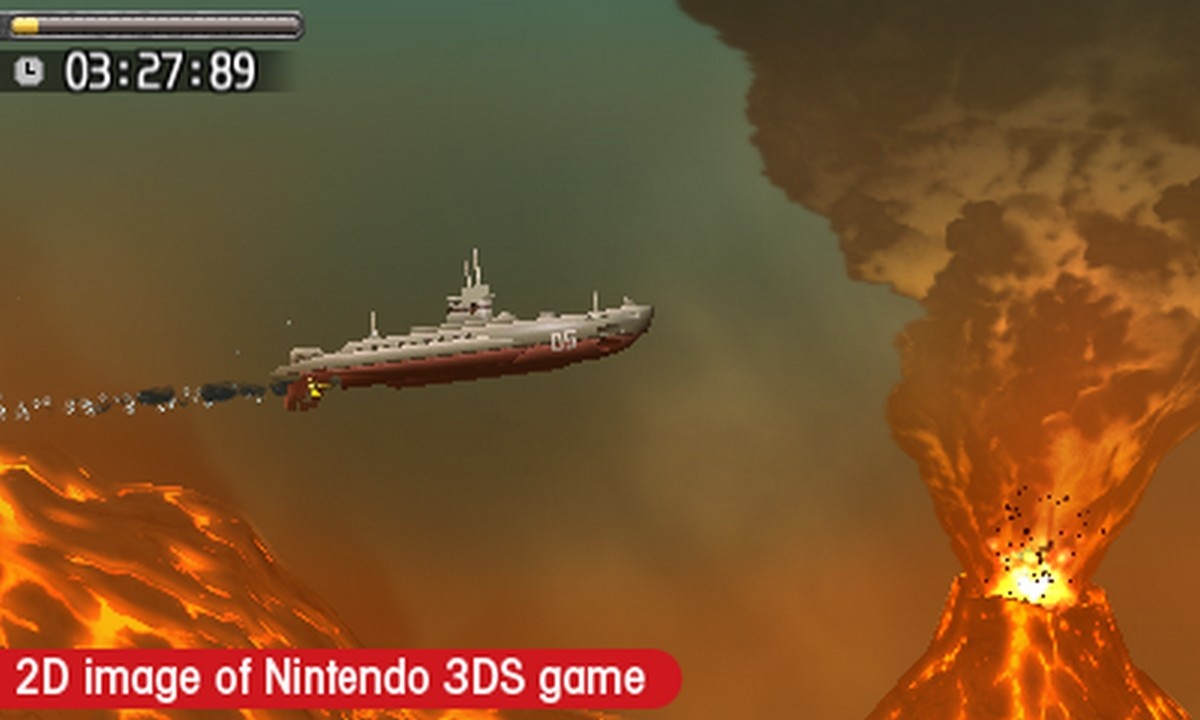Steel Diver is a drastic departure from what you'd expect in a game made by Nintendo. The company that created countless franchises with an emphasis on accessibility has taken a sharp turn in the opposite direction, and that shift is not for the better. This side-scrolling submarine adventure teeters between simulation and action, with compromises on both sides leading to a flat experience. Fiddling with the various sliders required to pilot your underwater craft demands the steady hand of an aspiring pilot, and there is momentary satisfaction when you successfully guide your submersible past a particularly nasty stretch. But punishment for making a mistake is so minimal that Steel Diver never taps into the pleasure zone that an actual simulation can call forth. On the other side of the coin, torpedo fights against enemy ships showcase the explosions you'd expect from an action game, but sluggish controls make lining up your shots too taxing to elicit much of a thrill. Steel Diver can't decide what it wants to be, and that ultimately leads to a disappointing launch game for Nintendo's latest handheld.
There's a brief setup about a war taking place in the year 19XX, but the story is mostly ignored for the rest of the game. Instead of focusing on what your motivation is, you need to be concerned with staying alive. The seven missions that make up the bulk of Steel Diver have you guiding your submarine through a series of dangerous undersea realms, with jagged icebergs and erupting volcanoes providing as much danger as the enemy subs trying to sink your modest craft. Action plays out from a 2D perspective, and there are three different submarines available. From small and swift to large and lumbering, each craft has a distinct feel, though they're similar enough that switching between them requires only a minor adjustment.
Controls are mostly handled on the touch screen. A vertical slider adjusts your depth, while a horizontal one determines the direction of your movement. The farther you push the slider in either direction, the faster you move, and it takes a fair bit of concentration to stay on course. Because you're underwater, changing direction isn't as easy as flicking a switch and watching your sub skirt potential dangers. Slowing down your momentum takes time, so you need to keep your eyes peeled for enemies and obstacles to ensure you can get out of the way. It sounds complicated, and it can be tough juggling these two commands during tense situations, but Steel Diver is so forgiving that you don't have to worry about sinking like a stone. Your sub can take a fair bit of damage, so though you may slam into mines and scrape your hull on stalagmites, death is an infrequent occurrence. You regenerate your health by surfacing for a few seconds, and your ship is even equipped with a cloak so you can hide from heat-seeking torpedoes. The foundation for an engaging, though simplified, take on simulations exists, but Steel Diver's slap-on-the-wrist punitive system ensures you make it through intact even if you're a sloppy pilot.
The objective in every mission is the same: Get from the left side of the map to the right as quickly as possible. Land formations create a natural maze for you to navigate, and tweaking your trajectory so you can glide past environmental dangers brings a modicum of satisfaction. There are also foreign ships and subs that fire missiles and torpedoes when you get close, drop depth charges if you venture below them, and pepper the water with mines to add to your troubles. Each of your subs is equipped with its own torpedoes, and though it can be fun to send these aggressors to Davy Jones's Locker, don't expect much excitement. The slow-reacting controls mean that fights take a while to play out. It takes a bit of fiddling to aim in the right direction, and because you withstand so much damage before you die, there's little fear while you line up your shots.
In addition to the regular missions, three bosses stand between you and survival. These oversized enemies follow a specific pattern that ensures they're only vulnerable during certain moments, and this is where the sluggish controls become downright annoying. For instance, a persistent tanker is your second boss, and though it isn't tough to get past it in your first life, it takes an awfully long time to whittle away its health. You can only hurt it when it opens a hatch to drop charges, mines, and missiles your way, and being in the right position at that moment is not always possible. Its attacks aren't particularly scary because you absorb so many hits before you die, but they can knock you out of the way and ruin your chance to retaliate. The ship also cruises around when it gets bored, and you have to wait for it to return to its attack position before you get a chance to unleash a few more rounds. It's a constant challenge to adjust your sliders so you're in the right position at the precise moment that the ship becomes vulnerable, which becomes tedious as the minutes begin to drag. This could have been exciting if your life were in danger, but that's rarely the case. This is a war of attrition with no real winner.
When you complete any of the missions, you're whisked away to a periscope challenge in which you must sink enemy boats from a first-person perspective. This is the lone moment where the action raises to a thrilling level, and that fun bubbles forth because of the carefree controls and strict time limit. You swing your view by manually moving the 3DS in a circle. When you spin around in real life, the onscreen view will do the same, and whipping around as quickly as possible to find lurking threats provides an immediate rush. You tap a button to unleash your torpedo barrage, and you have to be mindful of the momentum of your enemies if you're going to be successful. If you make sure you lead them appropriately, you can sink them with one shot. There isn't much depth in this mode, but it hardly matters. The whole shebang is done in a mere 30 seconds, so you're constantly engaged without any fear of it overstaying its welcome. You can go directly to this mode at any time from the main menu, but that's a bad idea. In long doses, this becomes as dull as the main game, so it's better to partake in it sparingly to avoid sinking the fun.
The uneven gameplay in Steel Diver carries over to the visuals as well. The side-scrolling missions have striking backgrounds that do a good job of making you feel as if you're underwater. A variety of locales give you a stylish taste of the earth's many climates, and the attention to detail adds to the immersion. Bubbles form and pop realistically, and the fiery burst when you land a solid hit jumps off the screen. When you flip on the 3D display, it's like you're staring into a tiny fish tank, though the depth of field can get nauseating in long stretches. In contrast to the sharp backgrounds are elements that look bland in comparison. Your submarine, for instance, looks like the prize at the bottom of a cereal box, and the enemy ships look just as phony. The periscope perspective is equally mundane. The rhythmic motion of the waves and clouds do little to conjure a longing for the open water.
A single-card two-player mode resembling the popular board game Battleship extends the life of this short game for a little while. Armed with a fleet of five ships, each player takes turns hunting down the other while keeping his or her own boats afloat. Your opponent's ships are invisible to you, so moving with trial-and-error precision to suss out your enemy's location makes up a large portion of the strategic pull. When you land on an occupied space, a fight breaks out to determine who controls that area. If you're manning a submarine, you reenact the periscope challenges, only this time your opponent can move his or her ships out of the way. This mode heavily favors the offensive player because ships take so long to react to your commands, which sucks away much of the excitement of deadly torpedo strikes. When you move one of your ships onto a space containing your opponent's submarine, a different minigame opens. Here, the offensive player chooses among three depths to drop charges, and the defensive player chooses from the same three options for how deep to hide. This is based entirely on luck so it engenders little satisfaction. Because of the constant minigame interludes in this mode, it has a sluggish pace compared to Battleship and becomes tiring before the first match has been decided.

Steel Diver never figures out if it wants to be a submarine simulation or an action romp, and that indecision leads to a yawn-inducing experience. And to make matters worse, even if you do get sucked into this adventure, there isn't much content on offer. You can play through the seven missions in a few hours, and once you're done with that, there are a handful of time-trial missions but little else to occupy your time. The dull two-player mode certainly doesn't add much value, so you're stuck with a middling game that's over before you know it. The novelty of seeing an underwater world through the wonders of 3D is certainly fascinating for a little while, but once that excitement fades away, there's not much here to keep you engaged. Steel Diver sets out from port brimming with confidence, but it sinks to the briny depths before it leaves the harbor.
